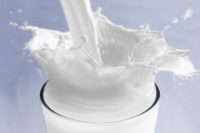
Low-Fat Dairy Foods: A Healthy Choice for the Whole Family
by Lori Hoolihan and Peggy Biltz
Dietary guidelines from federal agencies and major health organizations strongly recommend the inclusion of low-fat and fat-free dairy foods in daily dietary patterns.
This perspective was reinforced in April with the
release of a report by the Institute of Medicine concerning foods offered
to students. The report, “Nutrition Standards for Healthy Schools:
Leading the Way Toward Healthier Youth,” recommended serving fat-free
or low-fat milk and dairy products, since they are important to health and
the development of healthful lifelong eating patterns. This is consistent
with the USDA’s food guidance system “MyPyramid,” which
supports that most of the recommended three cups of milk (or equivalent
amounts of other dairy products) per day come from fat-free or low-fat
milk, yogurt and cheese.
The list of health benefits associated with dairy
foods is impressive and growing. They are well known as a great source of
protein, calcium, potassium and magnesium, along with other important
vitamins and minerals. Fortified dairy products can be an excellent source
of vitamins A and D and probiotics. Research documenting dairy’s
positive role in bone health is well-established; areas such as preventing
colon cancer and hypertension and assisting with weight management efforts
are also compelling.
A recent study from The American Journal of Clinical
Nutrition found that fat-free milk was more effective than a soy-based
drink in rebuilding muscle and recovering from exercise. After a 10-week
period, the men in the study who drank skim milk produced twice as much
muscle mass. Researchers believe that casein in cow’s milk may have
contributed to the improved muscle growth.
New research is also linking low-fat dairy foods to a
reduced risk of developing type 2 diabetes. In a recent large-scale
prospective study, men consuming higher levels of dairy foods, specifically
low-fat products, had a significantly lower risk of developing type 2
diabetes during a 12-year period. Each serving-per-day increase in dairy
consumption resulted in a 9 percent reduction in the risk of developing
diabetes. A similar study found that a calcium-rich diet including low-fat
dairy products (such as low-fat or skim milk, yogurt, sherbet and cottage
or ricotta cheese) reduced the risk of type 2 diabetes in middle-aged and
elderly women.
Low-fat dairy foods are also an important component of
the DASH diet (Dietary Approaches to Stop Hypertension), a diet shown to
not only reduce blood pressure in people with mild hypertension, but also
one that is recommended as a model eating pattern by the Dietary Guidelines
Advisory Committee and reflected in MyPyramid.
The family of dairy products offers a wide range of
fat and calorie options, allowing consumers to choose low-fat or fat-free
selections as part of a core eating pattern while still enabling them to
round out those choices with favorite higher-fat and calorie dairy products
in limited amounts. The versatility of dairy products available —
with their range of product offerings and flavors as well as fat and
calorie levels — offer a way to meet the individual health needs and
preferences of the entire family.
Peggy Biltz is chief executive officer of the Dairy
Council of California. Lori Hoolihan, Ph.D., R.D., is the council’s
nutrition research specialist.
$OMN_arttitle="Low-Fat Dairy Foods: A Healthy Choice for the Whole Family";?>
$OMN_artauthor="Lori Hoolihan Peggy Biltz";?>

